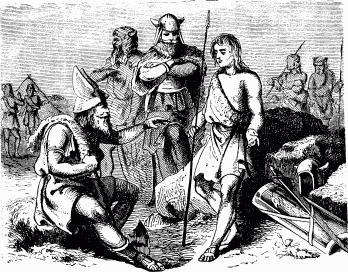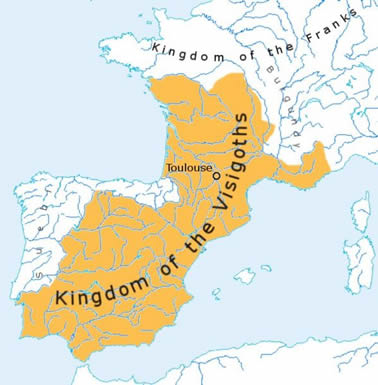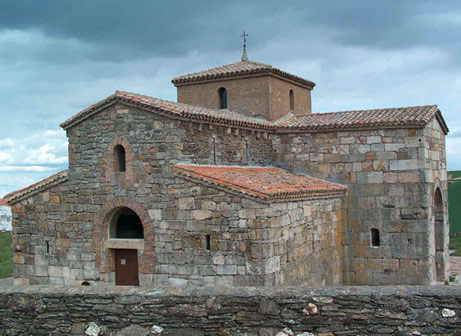
Illustration of the Goths |
The Visigoths were one of two main branches of the East Germanic tribe known as "Goths" (the other tribe is the Ostrogoths). The Goths were among the Germanic peoples who disturbed the late Roman Empire during the Migration Period, following a Visigothic force led by Alaric I's sacking of Rome in 410.
After the collapse of the western Roman Empire, the Visigoths played a major role in western European affairs for another two and a half centuries.
The division of the Goths is first attested in 291.[1] Cassiodorus, a Roman in the service of Theodoric the Great, invented the term "Visigothi" to match that of "Ostrogothi", which terms he thought of as "western Goths" and "eastern Goths" respectively.[6] The western-eastern division was a simplification and a literary device of sixth-century historians where political realities were more complex.[11] Furthermore, Cassiodorus used the term "Goths" to refer only to the Ostrogoths, whom he served, and reserved the geographical term "Visigoths" for the Gallo-Spanish Goths. This usage, however, was adopted by the Visigoths themselves in their communications with the Byzantine Empire and was in use in the seventh century.[11]
War with Rome (376–382)
The Goths remained in Dacia until 376, when one of their leaders, Fritigern, appealed to the Roman emperor Valens to be allowed to settle with his people on the south bank of the Danube. Here, they hoped to find refuge from the Huns. Valens permitted this. However, a famine broke out and Rome was unwilling to supply them with the food they were promised nor the land; open revolt ensued leading to 6 years of plundering and destruction throughout the Balkans, the death of a Roman Emperor and the destruction of an entire Roman army.
The Battle of Adrianople in 378 was the decisive moment of the war. The Roman forces were slaughtered; the Emperor Valens was killed during the fighting, shocking the Roman world and eventually forcing the Romans to negotiate with and settle the Barbarians on Roman land, a new trend with far reaching consequences for the eventual fall of the Roman Empire.
Reign of Alaric I
The new emperor, Theodosius I, made peace with the rebels, and this peace held essentially unbroken until Theodosius died in 395. In that year, the Visigoths' most famous king, Alaric I, took the throne, while Theodosius was succeeded by his incapable sons: Arcadius in the east and Honorius in the west.
Over the next 15 years, years of uneasy peace were broken by occasional conflicts between Alaric and the powerful German generals who commanded the Roman armies in the east and west, wielding the real power of the empire. Finally, after the western general Stilicho was executed by Honorius in 408 and the Roman legions massacred the families of 30,000 barbarian soldiers serving in the Roman army, Alaric declared war. After two defeats in Northern Italy and a siege of Rome ended by a negotiated pay-off, Alaric was cheated by another Roman faction. He resolved to cut the city off by capturing its port. On August 24, 410, however, Alaric's troops entered Rome through the Salarian Gate, to plunder its riches in the sack of Rome. While Rome was no longer the official capital of the Western Roman Empire (it had been moved to Ravenna for strategic reasons), its fall severely shook the empire's foundations.
Visigothic Kingdom
 The Visigothic Kingdom was a Western European power in the 5th to 7th centuries, created in Gaul by the German people of the Visigoths when the Romans lost their control of their empire. From 407 to 409 the Vandals, with the allied Alans and Germanic tribes like the Suevi, swept into the Iberian peninsula. In response to this invasion of Roman Hispania, Honorius, the emperor in the West, enlisted the aid of the Visigoths to regain control of the territory. In 418, Honorius rewarded his Visigothic federates by giving them land in Gallia Aquitania on which to settle. This was probably done under hospitalitas, the rules for billeting army soldiers (Heather 1996, Sivan 1987). The settlement formed the nucleus of the future Visigothic kingdom that would eventually expand across the Pyrenees and onto the Iberian peninsula. The Visigothic Kingdom was a Western European power in the 5th to 7th centuries, created in Gaul by the German people of the Visigoths when the Romans lost their control of their empire. From 407 to 409 the Vandals, with the allied Alans and Germanic tribes like the Suevi, swept into the Iberian peninsula. In response to this invasion of Roman Hispania, Honorius, the emperor in the West, enlisted the aid of the Visigoths to regain control of the territory. In 418, Honorius rewarded his Visigothic federates by giving them land in Gallia Aquitania on which to settle. This was probably done under hospitalitas, the rules for billeting army soldiers (Heather 1996, Sivan 1987). The settlement formed the nucleus of the future Visigothic kingdom that would eventually expand across the Pyrenees and onto the Iberian peninsula.
The Visigoths' second great king, Euric, unified the various quarreling factions among the Visigoths and, in 475, forced the Roman government to grant them full independence. At his death, the Visigoths were the most powerful of the successor states to the Western Roman Empire.
The Visigoths also became the dominant power in the Iberian Peninsula, quickly crushing the Alans and forcing the Vandals into north Africa. By 500, the Visigothic Kingdom, centred at Toulouse, controlled Aquitania and Gallia Narbonensis and most of Hispania with the exception of the Suevic kingdom in the northwest and small areas controlled by the Basques. However, in 507, the Franks under Clovis I defeated the Visigoths in the Vouillé and wrested control of Aquitaine. King Alaric II was killed in battle.
After Alaric's death, Visigothic nobles spirited his heir, the child-king Amalaric, first to Narbonne, which was the last Gothic outpost in Gaul, and further across the Pyrenees into Hispania. The center of Visigothic rule shifted first to Barcelona, then inland and south to Toledo. From 511 to 526, the Visigoths were ruled by Theodoric the Great of the Ostrogoths as de jure regent for the young Amalaric.
In 554, Granada and southernmost Hispania Baetica were lost to representatives of the Byzantine Empire (to form the province of Spania) who had been invited in to help settle a Visigothic dynastic struggle, but who stayed on, as a hoped-for spearhead to a "Reconquest" of the far west envisaged by emperor Justinian I.
The last Arian Visigothic king, Liuvigild, conquered the Suevic kingdom in 585 and most of the northern regions (Cantabria) in 574 and regained part of the southern areas lost to the Byzantines, which King Suintila reconquered completely in 624. The kingdom survived until 711, when King Roderic (Rodrigo) was killed while opposing an invasion from the south by the Umayyad Muslims in the Battle of Guadalete on July 19. This marked the beginning of the Muslim conquest of Hispania in which most of peninsula came under Islamic rule by 718.
A Visigothic nobleman, Pelayo, is credited with beginning the Christian Reconquista of Iberia in 718, when he defeated the Umayyads in battle and established the Kingdom of Asturias in the northern part of the peninsula. Other Visigoths, refusing to adopt the Muslim faith or live under their rule, fled north to the kingdom of the Franks, and Visigoths played key roles in the empire of Charlemagne a few generations later.
During their long reign in Spain, the Visigoths were responsible for the only new cities founded in Western Europe between the fifth and eighth centuries. It is certain (through contemporary Spanish accounts) that they founded four: Reccopolis, Victoriacum, Luceo, and Olite. There is also a possible fifth city ascribed to them by a later Arabic source: Baiyara (perhaps modern Montoro). All of these cities were founded for military purposes and three of them in celebration of victory.
Visigothic Religion

The Visigothic church of San Pedro de la Nave |
There was a religious gulf between the Visigoths, who had for a long time adhered to Arianism, and their Catholic subjects in Hispania. The Iberian Visigoths continued to be Arians until 589. For the role of Arianism in Visigothic kingship, see the entry for Liuvigild.
There were also deep sectarian splits among the Catholic population of the peninsula. The ascetic Priscillian of Avila was martyred by orthodox Catholic forces in 385, before the Visigothic period, and the persecution continued in subsequent generations as "Priscillianist" heretics were rooted out. At the very beginning of Leo I's pontificate, in the years 444-447, Turribius, the bishop of Astorga in León, sent to Rome a memorandum warning that Priscillianism was by no means dead, reporting that it numbered even bishops among its supporters, and asking the aid of the Roman See. The distance was insurmountable in the 5th century.[14] Nevertheless Leo intervened, by forwarding a set of propositions that each bishop was required to sign: all did. But if Priscillianist bishops hesitated to be barred from their sees, a passionately concerned segment of Christian communities in Iberia were disaffected from the more orthodox hierarchy and welcomed the tolerant Arian Visigoths. The Visigoths scorned to interfere among Catholics but were interested in decorum and public order.
The Arian Visigoths were also tolerant of Jews, a tradition that lingered in post-Visigothic Septimania, exemplified by the career of Ferreol, Bishop of Uzès (died 581).
In 589, King Reccared (Recaredo) converted his people to Catholicism. With the Catholicization of the Visigothic kings, the Catholic bishops increased in power, until, at the Fourth Council of Toledo in 633, they took upon themselves the nobles' right to select a king from among the royal family. Visigothic persecution of Jews began after the conversion to Catholicism of the Visigothic king Reccared. In 633 the same synod of Catholic bishops that usurped the Visigothic nobles' right to confirm the election of a king declared that all Jews must be baptised.
|
|
Related Links:
The Middle Ages
People of the Middle Ages
Joan of Arc
|


